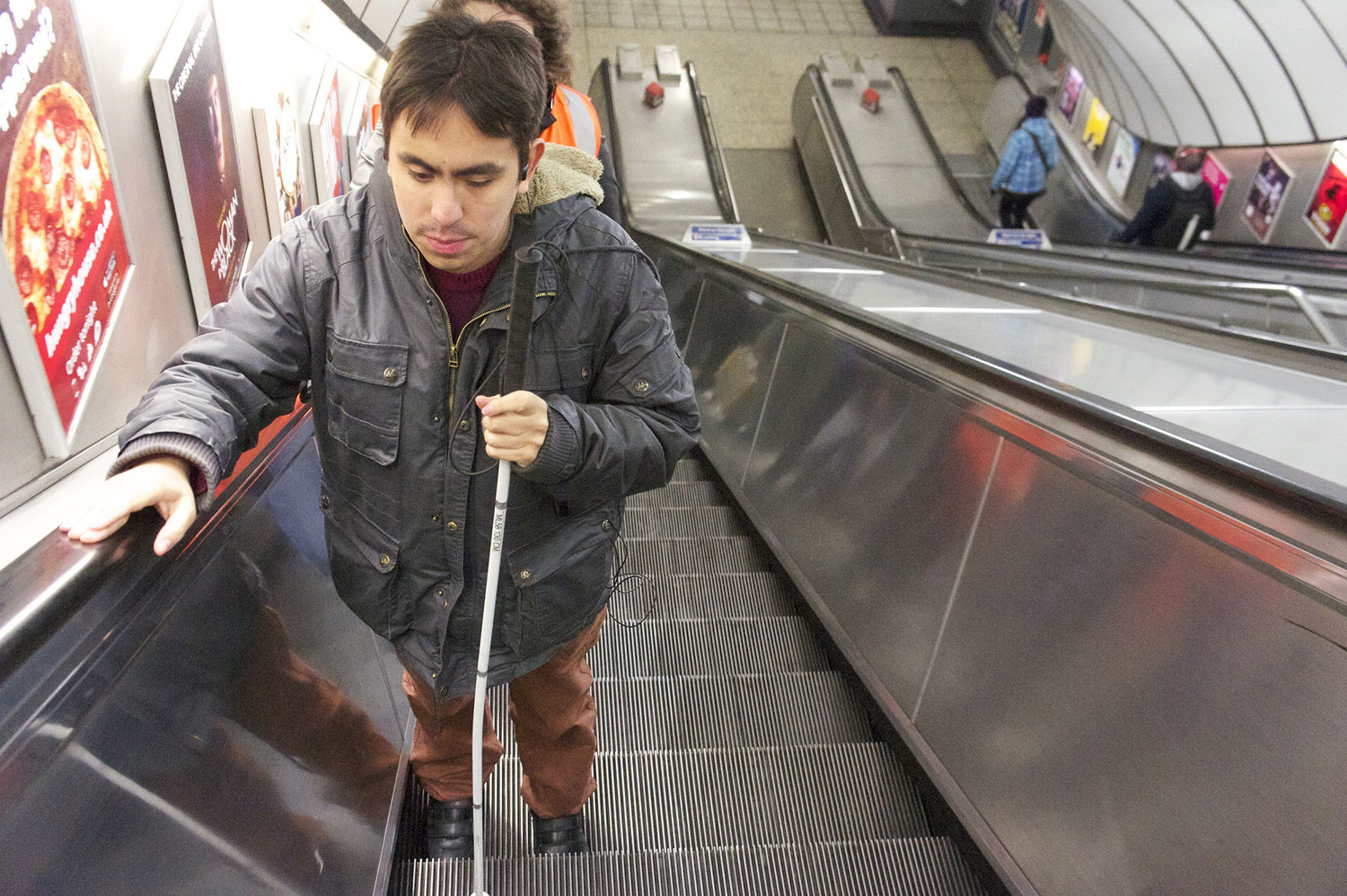How Wayfindr Guided My First Steps to Independence on the Tube

I’m standing at the top of the ramp into Pimlico station, phone in pocket and AfterShokz bone-conduction headphones resting snugly on my cheek bones. I suddenly hear a beep through the headphones and that clear British male voice infamous for voicing Siri up to iOS6 announces clearly and audibly, “Walk down the ramp into the ticket hall.”
My name is Kevin and I’m registered blind. I’m here with a team from global digital product studio ustwo, testing a prototype of Wayfindr. It’s a smart-phone app they have designed, in collaboration with the Royal London Society for Blind People’s (RLSB’s) Youth Forum, to guide blind people around the London Underground via Bluetooth beacons. The beacons, which have a unique ID, ping out a signal which the phone picks up, and then instructions associated to each beacon are read out loud to the blind person using the app.
I walk forward, cautiously at first, and begin my journey down the ramp to the ticket hall. A few seconds later the beep comes again and the app tells me I’m halfway down the ramp. Hmm useful. It’s getting darker, and the echo of the tube tunnel walls is becoming more pronounced as I descend.
“You are now approaching 9 steps down” says the voice. These short, clear, instructions are dead handy and are helping my orientation. They have been developed following detailed feedback from members of the RLSB Youth Forum, who first came up with the ideas that inspired Wayfindr.
Currently, blind and partially sighted commuters have to rely on station staff to assist them on to their train. They also to be met at their destination, by station staff. Wayfindr was born out of a dream for the vision impaired to be able to travel completely independently on the tube.
So far so good.

At the bottom of the stairs I’m immediately told to “Bear right towards the ticket barrier.” Because the bone conduction headphones are resting on my cheeks, I can clearly hear all the sounds around me. This makes my short walk to the barriers even easier, as I can hear the crash of the gates opening and closing, and the constant beep of oyster cards being tapped by the many commuters. Just as I think that I’m approaching the barriers, the app reassuringly confirms this. I stretch out my hand, and sure enough I touch the Oyster card reader. I am in awe at how accurate that instruction was. It really felt like a sighted guide walking next to me had told me exactly where I was.
Chatting to the guys from ustwo afterwards, they told me the beacons are constantly sending out a signal to ensure the app doesn’t miss one as we pass.
After going through the barriers, at first I don’t hear any instructions as to where to go next. Getting perfect coverage requires a lot of testing and the beacons are intended as an add-on to existing assistance available at the station. In this case, one of the tech team, George, helps out and nudges me on to the escalator. The beacons are battery operated, but with a 2-year life-span I’m not too worried about that being much of an issue.
Once on the escalator, George says, “pretend you are catching a tube to Brixton,”
“Ok no worries,” I reply.
As we reach the bottom the app comes to life and states, “Now approaching the end of the escalator,” closely followed by instructions to walk straight ahead to the end of the hall. When I get there, I find myself with the choice to either go left or right. The app says, “Turn right for trains to Brixton. Turn left for trains to Seven Sisters and Walthamstow Central.”
Awesome! I know where to go. I turn right, walk 10 paces and just as I step on to the platform, Wayfindr confirms this. All I would have to do now, if this was a real journey, would be to wait for my next train, confident in the knowledge I am on the right platform.
I’ve never been to Pimlico before, so the fact I’ve come down here guided by the app is a really big deal. It could save me an immense amount of time and make my journey less stressful, as I or any other vision impaired commuter wouldn’t have to worry if there are staff available to assist, a particular problem at night-time.
We then do the return journey back up to the exit, with Wayfindr giving me all the relevant instructions, signing off with a very pleasant, “Thank you for travelling on the London Underground,” once we reach the top of the ramp.
There is still a long road ahead to Wayfindr being rolled out to the masses. There is more testing to be done to ensure perfect coverage.
If Bluetooth Beacons are chosen to be the driving technology behind Wayfindr, a large number of them have to be installed across the London Underground. Though this can be done quite cheaply, the beacons still require maintenance to ensure the app functions properly. I nevertheless whole-heartedly believe it’s worth the investment. I felt empowered with the accuracy of the directions and I really felt like any other commuter walking down on my own to catch the train. I felt that Wayfindr guided me on my first steps to independence on the tube and could have a huge impact on the lives of blind and partially sighted people.
This post was first published on RLSB’s blog.
Find out more about Wayfindr here.
Our team combines the digital product and user centred design expertise of ustwo, with the Royal London Society for Blind People’s 175 years of experience working with blind people.